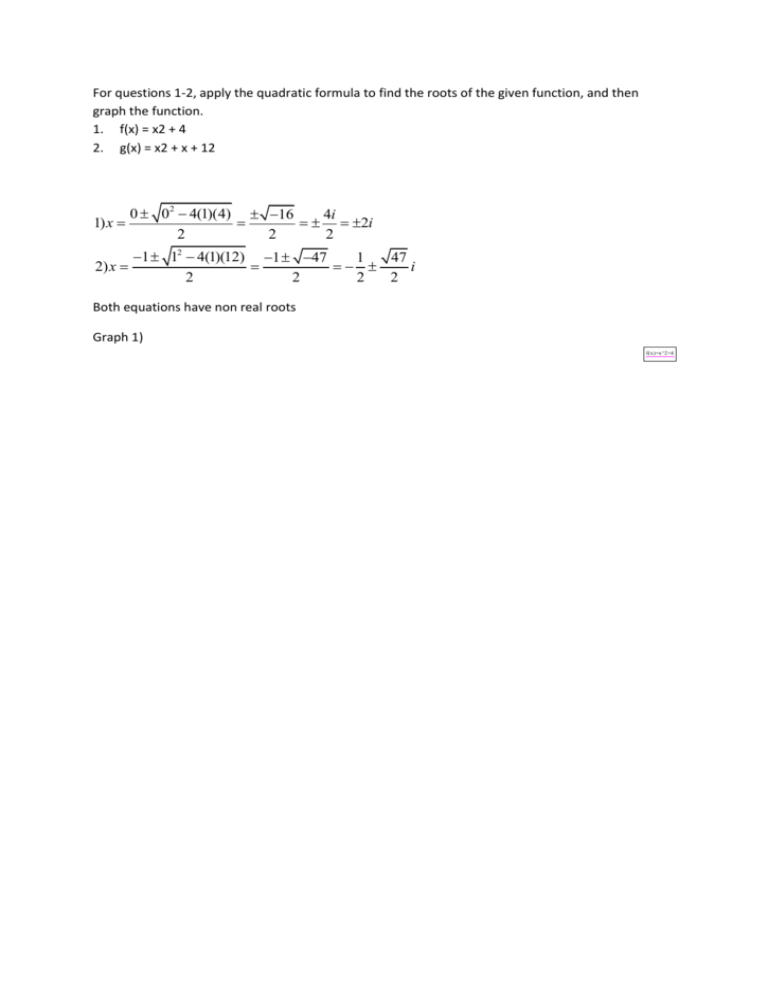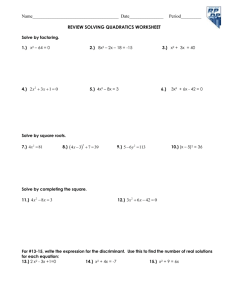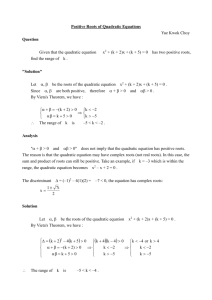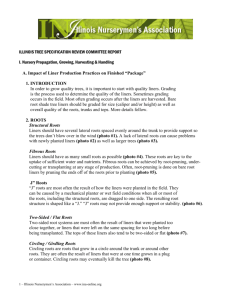For questions 1-2, apply the quadratic formula to find the roots of the
advertisement

For questions 1-2, apply the quadratic formula to find the roots of the given function, and then graph the function. 1. f(x) = x2 + 4 2. g(x) = x2 + x + 12 0 02 4(1)(4) 16 4i 1) x 2i 2 2 2 2) x 1 12 4(1)(12) 1 47 1 47 i 2 2 2 2 Both equations have non real roots Graph 1) y f(x)=x^2+4 18 16 14 12 10 8 6 4 2 x -5.5 -5 -4.5 -4 -3.5 -3 -2.5 -2 -1.5 -1 -0.5 0.5 1 1.5 2 2.5 3 3.5 4 4.5 5 5.5 Graph 2 y f(x)=x^2+x+12 18 16 14 12 10 8 6 4 2 x -5.5 -5 -4.5 -4 -3.5 -3 -2.5 -2 -1.5 -1 -0.5 0.5 1 1.5 2 2.5 3 3.5 4 4.5 5 5.5 For questions 3-4, factor the quadratic expression completely, and find the roots of the expression. 3. 135x2 - 222x + 91=0 135x2-222x+91=(15x-13)(9x-7), roots are 13/15 and 7/9 4. 6x2 - 42x + 72=0 6x2-42x+72 = 6(x2-7x+12)=6(x-3)(x-4), roots are 3 and 4 For question 5, complete the square, and find the roots of the quadratic equation. 5. x2 – 2x/3 = 0 X2-2x/3+1/9=(x-1/3)2 then x2-2x/3 = (x-1/3)2-1/9 (x-1/3)2-1/9=0 then (x-1/3)2=1/9 then x-1/3 =±(1/3) then x=±(1/3)+1/3 So roots are 0 and 2/3 In questions 6-10, use the discriminant to determine the number of solutions of the quadratic equation, and whether the solutions are real or complex. Note: It is not necessary to find the roots; just determine the number and types of solutions. Let d=discriminant= b2-4ac 6. 7. 8. 9. 10. 2x2 + x - 1 = 0 d=12-4(2)(-1)=9 >0 2 real solutions 2 4/3x2 - 2x + 3/4 = 0 d= (-2) -4(4/3)(3/4)=0 1 real solution 2 2x2 + 5x + 5 = 0 d= 5 -4(2)(5)=-15<0 2 non real solutions 2 3z2 + z - 1 = 0 d= 1 -4(3)(-1)=13>0 2 real solutions 2 m2 + m + 1 = 0 d=1 -4(1)(1)=-3 <0 2 non real solutions 11. A rectangular parking lot is 50 ft longer than it is wide. Determine the dimensions of the parking lot if it measures 250 ft diagonally. L=50+w Using Pythagoras theorem w2+(w+50)2=2502 2w2+100w+2500=62500 then 2w2+100w-60000=0 100 1002 4(2)(60000) 100 700 w 4 4 W is positive solution then w=150 ft, L=200 ft 12. Three consecutive even integers are such that the square of the third is 76 more than the square of the second. Find the three integers. Let n,n+2 and n+4 the integers (n+4)2=76+(n+2)2 then n2+8n+16=n2+4n+80 then 8n+16=4n+80 then 4n=64 Then n=16. Integers are 16,18 and 20 13. A photo is 3 inches longer that it is wide. A 2-inch border is placed around the photo making the total area of the photo and border 108in2. What are the dimensions of the photo? L=Length, W=wide L=w+3 Dimensions of the photo with the border are L+4 and W+4 Then area is (L+4)(W+4)=(W+7)(W+4)=108 W2+11w+28=108 W2+11w+28=108 then W2+11w-80=0 w 11 112 4(1)(80) 11 21 2 2 W is the positive solution so w=5 and L=8 Dimentions of the photo are: Length 8 inches Wide 5 inches







